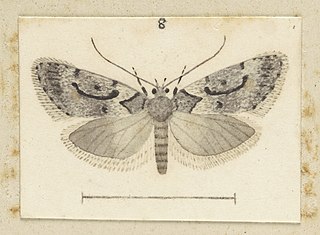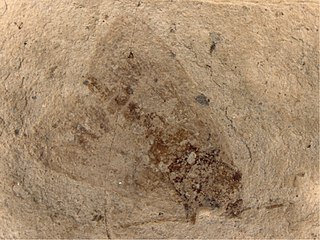
Elaeagnus angustifolia, commonly called Russian olive, silver berry, oleaster, or wild olive, is a species of Elaeagnus, native to western and central Asia, Iran, from southern Russia and Kazakhstan to Turkey, parts of Pakistan and parts of India. It is widely established in North America as an introduced species.
Albert Stewart Meek was an English bird collector and naturalist.

Mantellisaurus is a genus of iguanodontian dinosaur that lived in the Barremian and early Aptian ages of the Early Cretaceous Period of Europe. Its remains are known from Belgium (Bernissart), England, Spain and Germany. The type and only species is M. atherfieldensis. Formerly known as Iguanodon atherfieldensis, the new genus Mantellisaurus was erected for the species by Gregory Paul in 2007. According to Paul, Mantellisaurus was more lightly built than Iguanodon and more closely related to Ouranosaurus, making Iguanodon in its traditional sense paraphyletic. It is known from many complete and almost complete skeletons. The genus name honours Gideon Mantell, the discoverer of Iguanodon.

Attenborosaurus is an extinct genus of pliosaurid from the Early Jurassic of Dorset, England. The type species is A. conybeari. The genus is named after David Attenborough, the species after William Conybeare.
Ravanoa is a monotypic moth genus of the family Crambidae described by Frederic Moore in 1885. It contains only one species, Ravanoa xiphialis, described by Francis Walker in 1859, which is found in Sri Lanka, Myanmar and on Borneo.

Gynaephora is a genus of "tussock moths", also known as the Lymantriinae, within the family Erebidae. They are mainly found in the Holarctic in alpine, Arctic and Subarctic regions, and are best known for their unusually long larval development period. The life-cycle of Gynaephora groenlandica was once believed to take fourteen years, but subsequent studies reduced it to seven, still a very slow development rate that is extremely rare in the Lepidoptera. The caterpillars have five instars, with each instar lasting a year.
Lachana is a genus of moths in the subfamily Lymantriinae. The genus was described by Frederic Moore in 1888. It contains species native to alpine areas on high mountains in the south of the Central Asia. The females do not have wings and lay their eggs within their own old cocoons.

Camelopteryx is a monotypic moth genus in the family Geometridae. Its only species, Camelopteryx multicolor, is found in Mauritius in the Indian Ocean. Both the genus and species were first described by Joseph de Joannis in 1906.

Thectophila is a genus of moths in the family Cosmopterigidae, although some sources place it in the family Blastodacnidae. The genus contains only one species, Thectophila acmotypa. This species is endemic to New Zealand. It is classified as "Data Deficient" by the Department of Conservation.

Machaeroprosopus is an extinct genus of mystriosuchin leptosuchomorph phytosaur from the Late Triassic of the southwestern United States. M. validus, once thought to be the type species of Machaeroprosopus, was named in 1916 on the basis of three complete skulls from Chinle Formation, Arizona. The skulls have been lost since the 1950s, and a line drawing in the original 1916 description is the only visual record of the specimen. Another species, M. andersoni, was named in 1922 from New Mexico, and the species M. adamanensis, M. gregorii, M. lithodendrorum, M. tenuis, and M. zunii were named in 1930. Most species have been reassigned to the genera Smilosuchus, Rutiodon, or Phytosaurus. Until recently, M. validus was considered to be the only species that has not been reassigned. Thus, Machaeroprosopus was considered to be a nomen dubium or "doubtful name" because of the lack of diagnostic specimens that can support its distinction from other phytosaur genera. However, a taxonomic revision of Machaeroprosopus, conducted by Parker et al. in 2013, revealed that UW 3807, the holotype of M. validus, is not the holotype of Machaeroprosopus, while the species Machaeroprosopus buceros, Machaeroprosopus being a replacement name, with a fixed type species, for Metarhinus, is the combinatio nova of the type species of the genu: Belodon buceros. Therefore, the name Pseudopalatus must be considered a junior synonym of Machaeroprosopus, and all species of the former must be reassigned to the latter. This revised taxonomy was already accepted in several studies, including Stocker and Butler (2013). Stocker and Butler (2013) also treated M. andersoni as a valid species, and not a junior synonym of Machaeroprosopus buceros as was previously suggested by Long and Murry (1995).

Stigmella progama is a species of moth in the family Nepticulidae. This species is endemic to New Zealand. It is classified as "Data Deficient" by the Department of Conservation. S. progama has only been collected on Bold Peak in Otago.

Izatha manubriata is a moth of the family Oecophoridae. It is endemic to New Zealand, where it is known from the southern South Island only.

Paleolepidopterites is a collective genus of fossil moths which can not be placed in any defined family. The included species were formerly placed in the leaf-roller family Tortricidae and are known from fossils found in Russia and the United States. The collective genus contains three species: Paleolepidopterites destructus, Paleolepidopterites florissantanus, and Paleolepidopterites sadilenkoi, formerly placed within the genera Tortrix and Tortricites respectively. The three species were formally redescribed and moved to the new collective genus by Heikkilä et al. (2018).
Lachana alpherakii is a species of moth of the subfamily Lymantriinae first described by Grigory Grum-Grshimailo in 1891. It is found in the high mountains of Tibet and China.
Lachana selenophora is a species of moth of the subfamily Lymantriinae. It is found in alpine habitats on the high mountains in Central Asia.
Lachana sincera is a species of moth of the subfamily Lymantriinae. A single example was found in 1909 at high elevations in the Wakhan range of the Pamir Mountains of Tajikistan and is only known to have seen again since in 1961. This was also in the area, making it provisionally endemic to southern Gorno-Badakhshan.
Lachana kulu is a species of moth of the subfamily Lymantriinae from northern India seen once in 1913.

Dicallomera is a genus of tussock moths in the family Erebidae.
Dicallomera pumila is a little seen species of moth of the family Erebidae found in mountains in Kazakhstan and in the southern Urals.

Titanomis is a genus of moths containing a single species Titanomis sisyrota, also known as the frosted phoenix. Taxonomists have difficulty placing this moth within an existing superfamily. The species is currently regarded as endemic to New Zealand. Only ten specimens have ever been found and none since 1959; it is classified as "Data Deficient" by the Department of Conservation.











